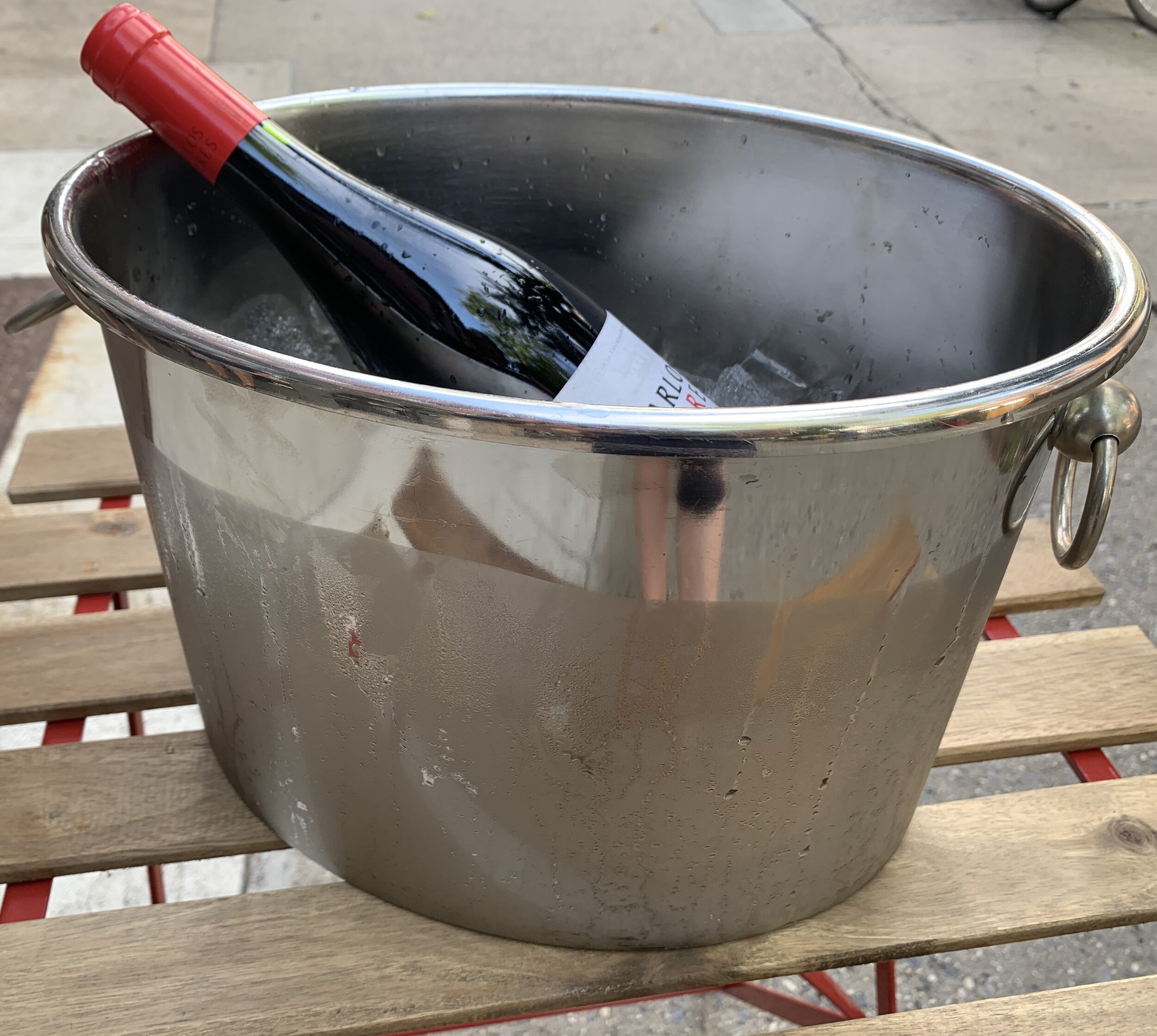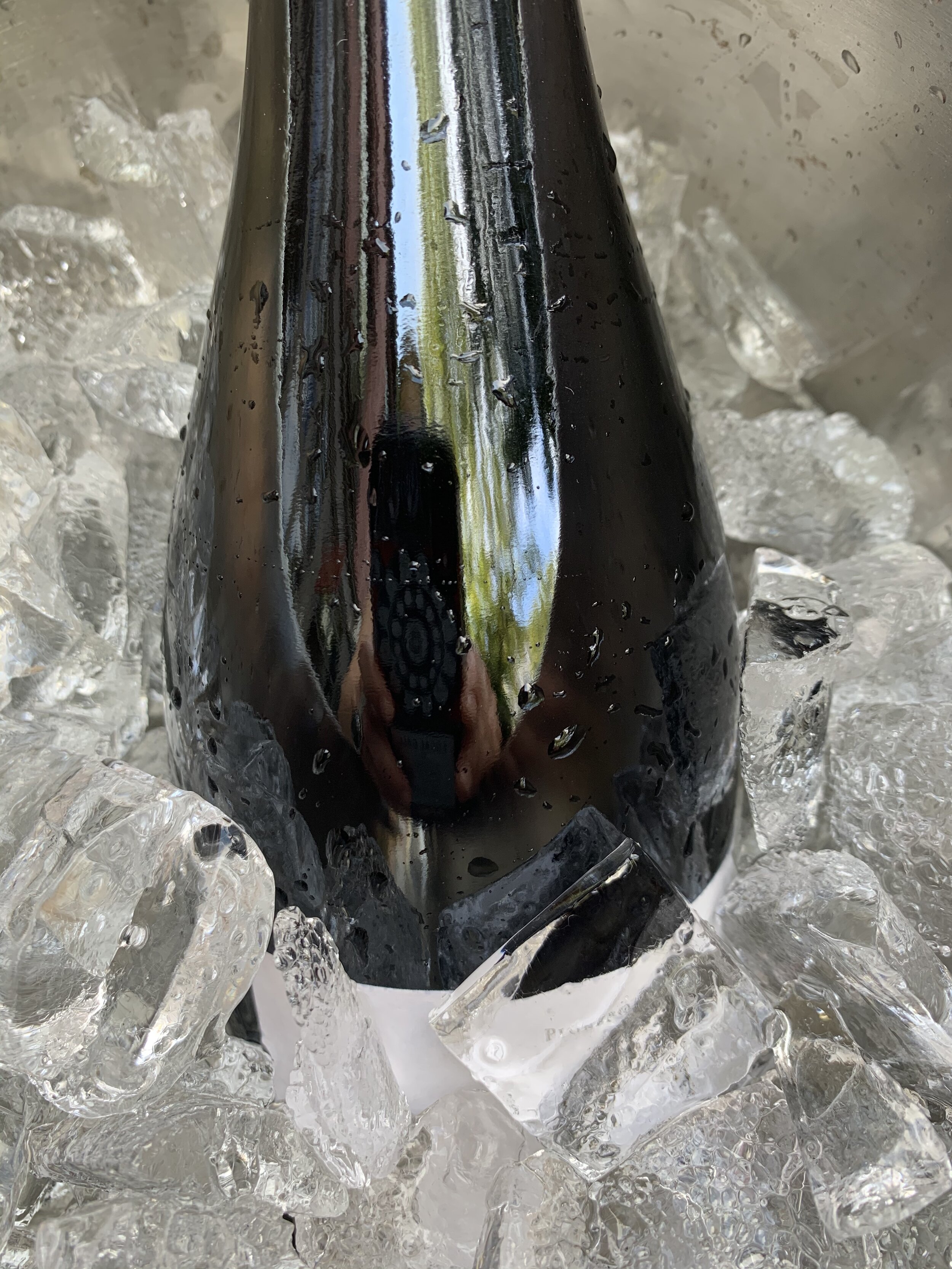Red Wine and Chill
Midsummer white and rosé wine fatigue? Try putting these reds on a little ice.
All photos by Amanda Schuster
Last week I finally had the opportunity to dine out. In Brooklyn, where I live, “dining out” literally means just that, because, as of press time, novel coronavirus safety precautions only allow for distanced outdoor seating in New York City. I don’t love eating and drinking on the sidewalk (if a venue has no back garden) in the pungent month of August, but what I did love was being asked if I would prefer the glass of Beaujolais I ordered to be chilled.
Oh, hell yes! On a hot mid summer night, after months of sipping rosé and white wines—universally and indefensibly served cold—without much variety in the routine, it’s so refreshing to not only taste something deeper, but to also literally be refreshed by the experience of drinking it.
I’d forgotten how much I love a chilled red. Last week’s Beaujolais was served at almost a full chill, which I don’t recommend for every wine, but was perfect in that context (in France, this is a typical summer serve, and for good reason). So many other reds—especially younger, fresher, light and medium-bodied ones—are delicious served slightly cold, after maybe 20 to 30 minutes in the fridge or from an ice bath. Not only does this cool the wine’s drinking temperature down and refresh the palate, it can also help accentuate certain nuances in flavors and aromas. Try it, for example, with an Italian Dolcetto, which are light to medium-bodied wines that are typically a bit tannic and acidic at room temperature; cooling them down a bit draws out ripe cherry, blood orange flavors and subtle spiciness.
I’m not suggesting you chill every red wine. Most full-bodied reds—think Napa cabs and merlots, big Aussie shiraz, brawny Barolo or Barbera, rich and spicy zinfandel, to name a few, or rather mature reds in general—are probably best served at a reasonable room temperature, around 60-ish degrees Fahrenheit/15 Celsius.
Below are some red wines to chill out with, and feel free to experiment with variations on these styles. Don’t worry. A delicately lowered temperature, as opposed to fully arctic storage, won’t “kill” your wine or dull its flavors. If you taste the wine and decide you’d prefer it warmer, well, the worst that can happen is you have to wait a few minutes to sip it at your desired temperature.
But first, chilled wine serving tips
To be clear, I’m not suggesting you serve the wine with ice cubes in the glass. They belong outside of the bottle to cool it down.
If you have a wine fridge, store red wines at around 55 degrees Fahrenheit/12 Celsius. If you want to sip them chilled, serve immediately at that cellar temperature.
Chill them in a regular refrigerator for 20 to 30 minutes and serve
Stick the bottles in a bucket with ice and cold water (ice bath) for 10 to 15 minutes, covering as much of the bottle as possible up to the neck, and keep chilled as you sip them
If you’ve chilled the wine and want to maintain its cooler temperature between glassfuls, but haven’t got an ice bucket or don’t feel like making repeated trips to the fridge, serve with a pre-frozen wine cooler sleeve around the base of the bottle (this is a terrific, inexpensive pandemic must-have accessory, with many styles available online)
Chillable reds from Spain and Portugal
Spain and Portugal get hot in the summer! Many indigenous Spanish and Portuguese grapes like tempranillo (found in all Rioja, Ribero del Duero and many other wines from all around the country as well as Portugal where it’s known as tinta roriz or aragonia), mencia (found in Ribeira Sacra), Catalonian wines that are super syrah-grenache heavy (like Priorat or Monstant), or Portuguese wines based on touriga nacional (which is pretty much all of them) just happen to be delicious with un poco cooldown.
Try:
Abadia Retuerta Seleccion Especial Sardon de Duero 2016: an elegant 75% tempranillo with 12% cabernet, 9% shiraz, 3% merlot, 1% petit verdot from Castilla y Leon ($30)
Bodegas Lan Xtrème 2015: Chilling is best with Crianza and younger (joven) Rioja styles, like this organic 100% tempranillo release from the historic Spanish estate. ($18)
Carlos Serras Crianza: give this zippy, juicy 100% tempranillo a try ($16.99)
Guímaro Ribeira Sacra 2018: deep, dark, luscious berry fruits in this mencia-dominated wine ($18)
DFJ Vinhos Portada Winemaker’s Selection Red Blend 2015: this Portuguese winery is a consistent winner in the NY International Wine Competition, and this red blend of tinta roriz, alicante bouschet, cabernet sauvignon, caladoc, castelao, pinot noir and touriga nacional is a divine value at $12.
Argentina
High altitude malbec and malbec blends from regions like Mendoza yield balanced fruit that benefits from a slight chill to draw out all of the wine’s character.
Try:
Amancaya 2017: a collaboration between the Domaines Barons de Rothschilde (Lafite) and Catena families, a fruity Malbec from Mendoza ($20)
Domaine Bousquet Virgen Organic Red 2019: from wayyyyyyyy up (1200 meters/4000 feet above sea level) high in Tupungato in Mendoza’s Uco Valley comes this Malbec/Cab Sauv/Cab Franc with no added sulfites (meaning additionally to the ones naturally occurring in grapes - people always misunderstand that and it drives me bonkers) ($13)
France and French Varietals
While some may say serving top vintage Grand Cru pinot noir-based Burgundy like Romanée-Conti on the colder side is an haute mess, you can’t argue what a bit of coolth does to the dark cherry and violet notes in younger, quality gamay-based wines like a Beaujolais from Morgon or Fleurie, or or one from Tauraine in the Loire Valley.
From the Loire, I’m a massive fan of Bourgeuil made from cabernet franc, which is a grape I like to serve with a little chill all year round anyway to draw out its raspberry, blueberry, and dark plum flavors from behind the backbone of earthiness and herbaceousness.
Moving farther south, certain wines from sun-baked regions like Languedoc-Roussillon, Rhône, Provence and Varois made from syrah, grenache, cab franc or other indigenous grapes, are produced in light to medium-bodied styles that make them ideal chillers too.
But one doesn’t need to stay in France to taste a fantastic lighter, less mature style of syrah, cab franc, grenache or even gamay.
Try:
Domaine Saint Gayan Gigondas 2015: this blend of 75% grenache, 20% syrah and 5% mourvedre from the Gigondas AOC in the Rhône gets just the right balance of jamminess from a wee chill, about 10 to 15 minutes. ($28)
W.T. Vintners Syrah Les Collines Vineyard 2014: from The Foothills in Washington’s Walla Walla Valley comes this slightly earthy and smoky syrah that almost drinks like a Rhône Cornas. ($45)
Georges Duboeuf Fleurie Domaine des Quatre Vents 2017: Yes, this estate is famous for its nouveau, but give this silky Cru Beaujolais gamay a try. ($25)
Hosmer Cab Franc 2018: one of my all time go-to summer reds, this Finger Lakes, NY cabernet franc (another consistent NY International Wine Competition medalist) is a barbecue wine hero. ($22)
Other reds to keep cooler (or serve from one)
Occhipinti Il Frappato 2017: Arianna Occhipinti is one of the world’s most talented winemakers. Here, she showcases the beauty of organically-grown 100% Sicilian frappato, delicately aged in Slovenian oak for 14 months. Put this deep, soothing red in an ice bucket, pour a glass, and turn off the world for a while. ($40)
Lenz Moser Blaufränkisch 2015: this Austrian grape (a.k.a. lemburger), has plummy and dark cherry flavors and a subtle hint of spice in the back palate. I think it’s best served almost completely cold. You cannot beat the value of this LITER bottle at around $12.
Stoneleigh Latitude Pinot Noir 2017: While a chilled Burgundy might not be a crowd-pleaser (even for a party of one), a fruity new world pinot noir, like this beauty (a gold medal winner in the 2019 NY International Wine Competition) from Marlborough, New Zealand is quite nice on ice. ($20)



